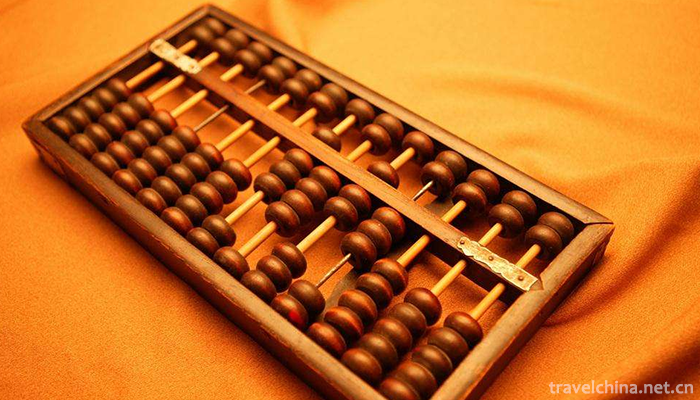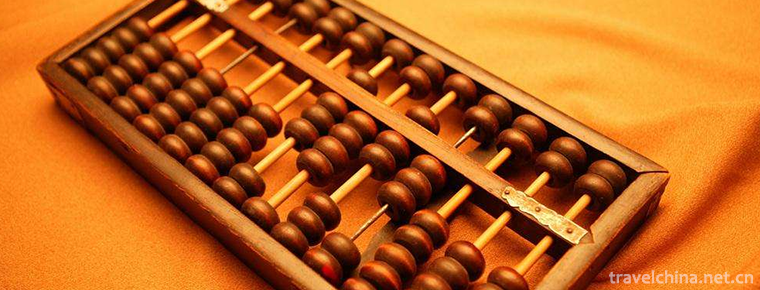Calculation with an abacus
Calculation with an abacus
Abacus abacus is a method of numerical calculation, which is known as the fifth largest invention in China.
Liu Hong (129-210 A.D.), a character Zhuo, a descendant of Liu Xing, the king of Lu in the Eastern Han Dynasty, is an outstanding astronomer and mathematician in ancient China. He is the inventor of abacus and the discoverer of the theory of lunar motion inhomogeneity. He is respected by later generations as "Sacred Calculator".
The abacus is a simple calculating tool invented and created by the working people in ancient China. The word "abacus" was first found in Xu Yue's Su Shu Ji Ji in the Han Dynasty. Among them, there are clouds: "abacus, controlling four seasons, three meridians and latitudes".
On June 14, 2008, the abacus declared by Tunxi District, Huangshan City, Anhui Province, and the China Association of Mental Arithmetic and Abacuation were listed in the second batch of national intangible cultural heritage list with the approval of the State Council.
On December 4, 2013, the eighth meeting of the UNESCO Intergovernmental Committee for the Protection of Intangible Cultural Heritage adopted a resolution in Baku, the capital of Azerbaijan, formally listing the Chinese abacus project on the UNESCO list of intangible cultural heritage of mankind. This is also China's 30th non-legacy project.
historical origin
The name of abacus arithmetic was first found in Sushu Jiji written by Xu Yue in the Han Dynasty. Now that the abacus has a history of more than 1800 years, it should be calculated on the basis of this time point. However, the abacus arithmetic at that time was quite different from today's . In the Song Dynasty "Qingming Shanghe Tu", you can clearly see an abacus on the counter of "Zhao Tai Chengjia" drugstore. Modern abacus arithmetic began between Yuan and Ming Dynasty. Zhu Shijie's Enlightenment of Mathematics in Yuan Dynasty contains 36 phrases, which are roughly the same as today's . During the Ming Dynasty, it gradually spread to Japan, Korea, Thailand and other places. Liu Yin (1248-1293) of the Yuan Dynasty had five-character quintessential sentences entitled Abacus in his Collection of Works of Mr. Jingxiu. Wang Zhenpeng, a painter of the Yuan Dynasty, has an abacus in his "A Tablet of Heaven and Kun" (1310). At the end of Yuan Dynasty, there is a metaphor of abacus beads in the 29 "well beads" clause of Tao Zongyi's "Nancun Dropping Farming Record" (1366). An interesting proverb is also recorded in this passage: "When a servant-in-law comes, he says to roll a plate of beads, but he does not dial them automatically; when he says to abacus beads, he moves when he says to dial them; when he says to Buddhist beads for a long time, his words are condensate all the time, though he does not dial them." Replace the "maidservant" here with some staff members of the functional department, and press the same stamp . The abacus was also mentioned in the Yuan Dynasty. From these examples, we can see that the abacus had been used in the Song Dynasty.
With the prosperity of commercial economy in Ming Dynasty, abacus arithmetic was widely popularized and gradually replaced budgeting under the conditions of commercial development. The earliest existing book containing abacus maps is the newly inscribed Qui Ben's Four Dialects Miscellaneous Characters in Four Years (1371) in Hongwu, Ming Dynasty. The earliest abacus book in existence is the revised Panzhu algorithm (1573) by Xu Xinlu, Fujian Jianou County. The most popular abacus book and the most important abacus book in history is "Directly Pointing Algorithms General Zong" compiled by Cheng Dawei of the Ming Dynasty. The State Council has listed Abacus in the second batch of national intangible cultural heritage catalogues.
On October 31, 2013, UNESCO published a list of alternatives for the 2013 masterpiece of the intangible cultural heritage of mankind, among which China's abacus is listed.
On December 2, 2013, the eighth meeting of the UNESCO Intergovernmental Committee for the Protection of Intangible Cultural Heritage opened in Baku, capital of Azerbaijani. The six-day meeting will consider nearly 30 non-legacy declaration items, including China's abacus.
On December 4, 2013, the United Nations Educational, Scientific and Cultural Organization (UNESCO) adopted abacus in Baku, the capital of Azerbaijani, which formally became the intangible cultural heritage of mankind. This is also the 30th non-legacy item in China.
Traditional structure
The traditional abacus in our country is the top two and the bottom five beads. The upper one represents "5" and the lower one represents "1", which is calculated with the abacus.
When calculating, we adopt "five-liter decimal system", that is, when each gear is "full of 5", we use a bead to express it, and when each gear is "full of 10", we move forward one gear "into 1". Therefore, it is enough to use only four beads for each gear. Why is the traditional abacus of our country the top two beads and the bottom five beads?
One of the reasons is that in ancient China, when calculating weight, we used the "16-2" system, that is, one kilogram equals sixteen-two. Modern people often say that two people are half-weight, which means they are the same as each other. But half a catty is half a catty, and Eight-two is eight-two. How can they be equal? Originally, in our ancient system of weight units, one kilogram equals sixteen or two, so half a kilogram equals eight or two. The top two and the bottom five beads can be calculated to "15" in each gear, so that "Man 16" will move forward one gear, so our traditional top two and bottom five beads abacus is formed to adapt to the hexadecimal system.
The second reason is that in ancient times, the first one was not enough, and the second one was necessary. Some old accountants were influenced by long-term habits and still liked to use the second and second five-pearl abacus, but both at home and abroad used the last four-pearl abacus.


-
1.Mutual Aid Tu Nationality Hometown
Huzhu Tujia Hometown Scenic Area is located in Weiyuan Town, Huzhu Tujia Autonomous County, Haidong City, Qinghai Province. It is 31 kilometers away from Xining City
Time 2018-12-12 -
2.Diaoyutai State Guest House
Diaoyutai State Guest House is an ancient imperial garden and modern State Guest House complex located on the east side of Yuyuantan (39 55'N 116 19'E) in Haidian District, Beijing, China
Time 2018-12-13 -
3.White Horse Temple Baima Temple
Baima Temple is located in Baima Temple Town, Luolong District, 12 kilometers east of the old city of Luoyang City, Henan Province. Founded in the eleventh year of Yongping in the Eastern Han Dynasty
Time 2019-01-02 -
4.Qinghai Provincial Museum
Qinghai Museum is located in the east of Xining Square in the west of Xining City. It is the first large-scale comprehensive museum with modern functions in Qinghai
Time 2019-02-07 -
5.Taoranting Park
Taoranting Park, located on the northwest side of Taoranqiao in the South Second Ring of Beijing, is a new modern urban garden, which integrates ancient and modern gardening arts and focuses on highli
Time 2019-02-13 -
6.Historic Architectural Complex in Heaven and Earth
Historic buildings in Tiandi, World Cultural Heritage, National Key Cultural Relics Protection Units and National AAAAA Tourist Scenic Spots are located in the hinterland and surrounding
Time 2019-02-21 -
7.Ah Xi Xian Ji
"Xianji" is an epic of the Ashi people of the Yi tribe, which is spread orally among the Ashi people in the Xishan area of Maile City, Yunnan Province. "Xianji" is the transliterat
Time 2019-03-28 -
8.Cai Luns Paper making Legend
Cailun Paper-making Stories and Legends are legends circulated in Cailun's fiefdoms, burial sites and experimental sites of Yangxian Longting and surrounding areas.
Time 2019-04-04 -
9.Wooden Fish Songs
Muyu song is short for Muyu, also known as Touyu song. It is one of the traditional rap and singing arts in Guangdong Province and belongs to the system of Tanci. It is popular in the Pearl River Delt
Time 2019-06-06 -
10.Flower hopping shed
Dancing Huapeng, introduced from Fujian in Ming Dynasty, is an ancient traditional folk dance, belonging to Nuo dance. It has a fixed "Keben" (singing desk book), which is divided into 18 br
Time 2019-06-21 -
11.Toleau
The phonetic translation of "Toleau" in Kazakh means "lyric", "lyric poem", "revelation song" and "propaganda narration". It is one of the oldest form
Time 2019-06-24 -
12.Deyang scenic spot
There are Sanxingdui ancient Shu civilization sites in Deyang City, where a large number of national treasure level cultural relics such as bronze Dali Man, bronze mask, bronze sacred tree, gold stick and Bian Zhang were unearthed. There are also the pangtong
Time 2020-12-14